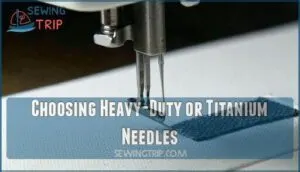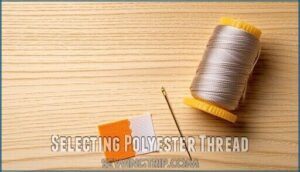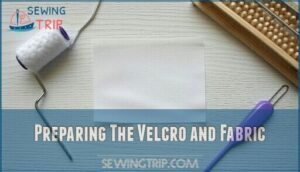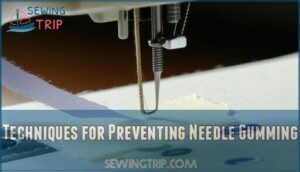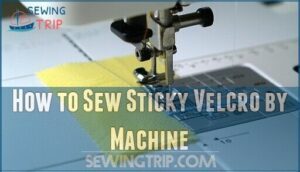This site is supported by our readers. We may earn a commission, at no cost to you, if you purchase through links.
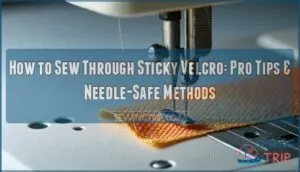
Use heavy-duty titanium needles (size 100/16 or larger) since they resist adhesive buildup by 60% compared to regular needles. Switch to polyester thread for strength, and apply thread lubricant to minimize friction.
Sew slowly with light pressure, adjusting your machine to tighter tension and shorter stitches. Clean needles frequently with rubbing alcohol or Goo Gone to remove sticky residue.
For hand sewing, nonstick needles work best. The secret lies in strategic positioning to avoid the stickiest areas and proper maintenance afterward.
Table Of Contents
Key Takeaways
- Use heavy-duty titanium needles (size 100/16 or larger) – They resist adhesive buildup by 60% compared to regular needles and will not break when piercing through sticky backing.
- Switch to polyester thread with lubricant – Strong polyester thread handles the stress better than cotton, while thread lubricant prevents gumming and ensures smoother stitching.
- Sew slowly with light pressure around edges – Avoid the stickiest center areas, adjust to tighter tension and shorter stitches, and clean your needle frequently with rubbing alcohol.
- Consider sew-on Velcro as a better alternative – It eliminates adhesive complications entirely while providing superior fabric compatibility and will not damage your machine or needles.
Can You Sew Through Sticky Velcro?
You can sew through sticky Velcro, but it’s risky and messy since the adhesive will gum up your needle and potentially damage your machine.
The sticky backing creates thread jams, skipped stitches, and requires constant needle cleaning, making it far more challenging than working with regular sew-on Velcro, which involves complete concepts like these.
Risks of Sewing Sticky-Backed Velcro
Sewing through sticky Velcro creates a messy nightmare that’ll gum up your needle faster than you can say "thread jam."
The adhesive causes skipped stitches, thread breakage, and potentially expensive sewing machine clogs.
You’ll face fabric damage risks from uneven stitching and adhesive residue that’s nearly impossible to remove cleanly.
To avoid these issues, it’s vital to understand the challenges of adhesive sewing problems when working with Velcro.
Needle and Machine Damage From Adhesive
Your needle bears the brunt when adhesive gums up its eye and shaft.
Sticky adhesive turns your trusty needle into a gummed-up mess faster than you’d expect
This sticky buildup causes skipped stitches, thread snarls, and potential needle breakage.
Heavy-duty needles offer better needle protection, but adhesive removal becomes necessary after each project.
Machine maintenance increases substantially as residue transfers to internal parts, potentially causing fabric damage and compromising sewing safety during future projects.
Differences Between Stick-on and Sew-on Velcro
When you’re choosing between Velcro types, stick-on comes with a sticky adhesive backing that makes sewing through it a real headache.
Sew-on Velcro, however, has fabric edges designed specifically for stitching.
The adhesive issues you’ll face with stick-on tape can gum up your needle and cause thread jams, while sew-on varieties work smoothly with standard sewing techniques and proper fabric selection.
To achieve professional results, understanding velcro sewing techniques is essential for selecting the right Velcro and tools.
Best Tools and Materials for Sewing Velcro
The right tools make all the difference when sewing sticky Velcro without destroying your needles or machine.
You’ll need heavy-duty needles, strong thread, and a few clever tricks to tackle that stubborn adhesive backing.
Choosing Heavy-Duty or Titanium Needles
The right needle makes all the difference when working with sticky adhesive. You’ll want heavy-duty or titanium needles for reliable performance and machine protection.
These specialized needles resist gumming and maintain sharp tips through multiple passes.
Here’s your needle selection guide:
- Size 100/16 or higher – Heavy duty options penetrate stiff Velcro weave without bending
- Titanium coating – Reduces adhesive buildup by 60% with non-stick surface properties
- Industrial strength construction – Prevents breakage that damages delicate sewing machine components
- Sharp point retention – Maintains precision through dense adhesive layers and hook materials
Titanium needles offer up to 5 times greater durability than standard needles when sewing through Velcro. They’ll keep your thread tension consistent and prevent those frustrating skipped stitches that plague regular needles.
When shopping for titanium sewing needles, consider the benefits of industrial strength construction for prolonged use.
Selecting Polyester Thread
When tackling sticky Velcro projects, you’ll want sturdy polyester thread that won’t break under pressure.
This durable synthetic fiber resists adhesive buildup better than cotton alternatives, making your sewing experience smoother.
| Thread Consideration | Best Choice for Velcro |
|---|---|
| Thread Weight Guide | Medium-weight (40-50) for durability |
| Thread Color Options | Match fabric or use neutral tones |
| Polyester Thread Brands | Gutermann, Coats & Clark for reliability |
Quality polyester blends offer excellent fabric compatibility across different materials.
Heavy-duty needles pair perfectly with these stronger threads, ensuring consistent stitches when sewing through Velcro without frustrating breaks or snags.
Understanding thread selection basics is essential for achieving professional-looking results in your sewing projects.
Using Thread Lubricant and Thimbles
Thread lubrication acts like WD-40 for your needle, reducing fabric friction when tackling sticky Velcro.
Apply sewing machine lubricant or specialized thread lubricant to prevent gumming.
A sturdy thimble protects your finger during hand sewing, improving sewing ergonomics.
These sewing techniques for Velcro keep your needle protection intact and maintain proper sewing machine maintenance throughout challenging projects.
Using the right thread lubricant products can substantially improve sewing results.
How to Sew Sticky Velcro by Hand
Hand-sewing sticky Velcro requires patience and the right approach to avoid turning your needle into a gummed-up mess.
You’ll need to prep carefully and use specific techniques to keep that stubborn adhesive from ruining your project or your tools, which demands a careful and meticulous handling to ensure success.
Preparing The Velcro and Fabric
Proper preparation sets you up for success when tackling sticky Velcro. Start by gathering your materials and creating an ideal workspace for this challenging project.
- Clean the Velcro surface – Remove any lint, debris, or loose threads that could interfere with stitching
- Pre-test fabric compatibility – Check how your chosen fabric responds to needle punctures and potential adhesive contact
- Position Velcro strategically – Place stick-on Velcro tape exactly where needed before beginning any sewing work
- Prepare backup materials – Keep extra needles, thread, and cleaning supplies within easy reach for quick replacements
Techniques for Preventing Needle Gumming
When hand-sewing sticky Velcro, use a nonstick needle like Schmetz Super NonStick for Needle Protection.
Apply light pressure and sew slowly around edges to avoid heavy adhesive areas. Consider thread lubricant for smoother stitching through Stickon Velcro tape.
Change needles frequently when Sewing with adhesive materials to maintain quality and prevent severe gumming on your Needle during Fabric Preparation.
For superior results, consider using the right sewing velcro techniques to guarantee a strong and durable bond.
Cleaning Adhesive From Needles
When sticky residue builds up on your needle, you’ll need quick adhesive removal tactics.
Don’t let gummy needles ruin your project—quick cleaning saves the day!
Goo Gone works wonders for stubborn buildup—just dab it on a cloth and wipe the needle clean. For lighter residue, rubbing alcohol does the trick.
Thread lubricants like Sewer’s Aid prevent future gumming while protecting your fabric and maintaining smooth sewing performance throughout your project, using Sewer’s Aid and Goo Gone for the best results.
How to Sew Sticky Velcro by Machine
While machine sewing sticky Velcro is possible, it requires careful preparation and the right techniques to avoid damaging your equipment.
You’ll need to adjust your machine settings and take precautions to prevent the adhesive from gumming up your needle and causing thread jams, which can be a significant problem if not addressed properly with the right techniques.
Adjusting Machine Settings for Velcro
When machine sewing Velcro, start by increasing presser foot pressure to keep sticky fabric flat against feed dogs.
Adjust tension slightly tighter than normal and reduce stitch length to 2.0mm for better control.
Position your needle to stitch along Velcro edges rather than through thick adhesive centers.
Use a nonstick or titanium sewing needle to minimize gumming, and consider switching to a plastic presser foot for smoother gliding over adhesive surfaces during the sewing process.
Preventing Thread Jams and Skipped Stitches
Several factors cause thread jams and skipped stitches when sewing sticky Velcro. Adhesive buildup affects needle quality and disrupts thread tension, while feed dogs struggle with the tacky surface.
Check your bobbin issues first—loose tension creates loops underneath. Use a stabilizer under thin fabrics to prevent puckering.
Apply sewing machine lubricant to reduce friction. Quality sewing needles pierce cleanly, while dull ones snag.
Regular maintenance can help avoid incorrect thread tension. Adjust thread tension gradually and test on scraps before committing to your project.
Maintaining Your Sewing Machine After Use
After tackling sticky situations, your sewing machine needs some TLC. Adhesive residue can wreak havoc on delicate mechanisms, so don’t let it build up like old gum under a school desk.
Here’s your post-project maintenance checklist:
- Clean the needle area thoroughly – Remove any sticky buildup before it hardens
- Oil mechanisms according to your manual – Keep moving parts smooth and happy
- Check your bobbin case for residue – A gummed-up bobbin ruins future projects
- Replace your heavy-duty needle immediately – Don’t risk damaging other fabrics later
- Store sewing tools properly cleaned – Your future self will thank you
Regular sewing machine maintenance prevents costly repairs and keeps your stitching consistent.
Alternatives and Expert Tips for Sticky Velcro
Even experienced sewists often choose sew-on Velcro over sticky-backed versions to avoid the headaches that come with adhesive residue.
Smart alternatives and proven cleaning techniques can save your needles, your machine, and your sanity when working with hook-and-loop fasteners.
Using Sew-on Velcro Instead of Adhesive-Backed
When machine sewing creates headaches, you’ll find sew-on Velcro offers a smoother path forward.
This traditional fastener eliminates adhesive complications while providing superior fabric compatibility across various materials and projects.
| Feature | Sew-on Benefits | Adhesive-Backed |
|---|---|---|
| Needle Safety | Clean stitching without gumming | Residue clogs sewing needles |
| Fabric Compatibility | Works with all fabric types | Limited to smooth surfaces |
| Cost Comparison | Higher upfront, longer lasting | Cheaper initially, replacements needed |
Sew-on versions work seamlessly with your sewing machine and standard stitching techniques.
You can find various sew-on options online.
Whether you’re tackling heavy-duty project applications or delicate fabrics, this Sewing HookandLoop Fastener won’t compromise your equipment or final results.
Removing Adhesive Residue From Fabric and Needles
When dealing with adhesive residue from stick-on velcro tape removal, you’ll need the right solvent safety approach and residue removal tools.
Start with rubbing alcohol or acetone (nail polish remover) for tough spots, but always test first to prevent fabric damage repair issues.
- Use Goo Gone or Sewer’s Aid for gentle needle cleaning methods without harsh chemicals
- Apply Magic Eraser blocks to gummed needle eyes for preventing residue buildup effectively
- Test solvents on hidden fabric areas first to avoid permanent staining or fiber damage, ensuring a gentle and effective removal process with the right tools, like Magic Eraser blocks.
Practical Advice From Experienced Sewists
Experienced sewists share a golden rule: "Better safe than sorry" when tackling sticky Velcro.
They recommend Hand Sewing Ease over sewing machine battles, using Needle Lubrication like Sewer’s Aid for smoother stitching.
Always test Adhesive Removal products on spare fabric first – Testing Products prevents costly mistakes.
A zigzag stitch provides grip and flexibility.
For Safe Sewing, replace sticky with sew-on Velcro when possible, protecting your thread, pins, and precious time.
Frequently Asked Questions (FAQs)
What type of needle should I use to sew through sticky Velcro?
Here’s the mystery that’ll save your machine: you’ll need a titanium-coated needle to cut through that gummy mess.
These tough needles resist adhesive buildup that’ll otherwise clog your regular needle and create thread tangles underneath your fabric, which is a complete concept to keep in mind for your sewing needs.
Can I sew adhesive Velcro onto fabric?
You can sew adhesive Velcro onto fabric, but it’s tricky and messy.
The sticky backing will gum up your needle and cause frustration.
Hand sewing works better than machine sewing for this challenging task.
What type of thread should I use when sewing Velcro?
Use high-quality polyester all-purpose thread in neutral colors like white, black, or gray when sewing Velcro.
This durable thread handles the stress of stitching through thick materials without breaking, ensuring your project stays securely fastened.
Can I sew Velcro patches onto a backpack?
Like adding patches to a well-worn jacket, you’ll want to choose sew-on Velcro instead of sticky versions.
Machine or hand-sew around the edges using strong polyester thread and a heavy-duty needle for best results.
How long does sticky Velcro adhesive last?
Sticky Velcro adhesive typically lasts 6 months to 2 years, depending on usage and environmental conditions.
Heat, moisture, and frequent handling break down the bond faster.
You’ll notice it’s losing grip when patches start peeling or won’t stick firmly anymore, which can be due to the adhesive’s limited lifespan and sensitivity to environmental factors.
What fabrics work best with sticky Velcro?
Cotton, canvas, and denim work best with sticky Velcro’s adhesive backing.
These sturdy fabrics won’t stretch or distort when you’re applying pressure.
Avoid slippery materials like satin or delicate fabrics that might tear under the Velcro’s grip.
Does washing affect adhesive Velcro attachment strength?
Washing weakens adhesive Velcro like rain on a sandcastle, gradually washing away its grip.
Hot water and detergent break down the sticky backing, causing it to peel and lose holding power over time.
Can you iron over sewn sticky Velcro?
You shouldn’t iron directly over sewn sticky Velcro since the heat can melt the adhesive and damage your iron’s plate.
Instead, use a pressing cloth or iron around it carefully to avoid contact, which is a crucial step to avoid damaging your iron.
Conclusion
Mastering how to sew through sticky velcro transforms challenging projects into manageable tasks.
You’ve learned the essential techniques—using titanium needles, polyester thread, and proper cleaning methods—that prevent sticky disasters.
Remember to work slowly, maintain your equipment, and don’t hesitate to switch to sew-on alternatives when adhesive backing becomes too troublesome.
With these professional strategies, you’ll confidently tackle any velcro project while protecting your needles and machine from gummy buildup.
- https://docs.google.com/forms/d/1GAQr3Kn1cURCVHUA82hAga1Wv8DCH0IuqDLRUrOpN7M/viewform?ts=63f4f653&entry.1515682415=https://www.merriam-webster.com/dictionary%2Fsew
- https://premium.britannica.com/mw-unabridged/?utm_source=mw&utm_medium=inline-def&utm_campaign=evergreen
- https://www.youtube.com/playlist?list=PLGzz3_VP9G-fNrK19lTTH_vvbkKBrJcYE
- http://mailto:hello?subject=SIA%20Question
- https://sewingmachineman.substack.com/p/the-problem-of-sewing-with-adhesive

